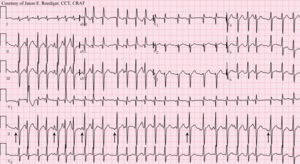Multifocal atrial tachycardia
| Multifocal atrial tachycardia | |
|---|---|
 | |
| Multifocal atrial tachycardia | |
| Classification and external resources | |
| ICD-9-CM | 427.89 |
| DiseasesDB | 31111 |
| MedlinePlus | 000186 |
| eMedicine | article/759135 |
Multifocal (or multiform) atrial tachycardia (MAT) is an abnormal heart rhythm,[1] specifically a type of supraventricular tachycardia, that is particularly common in older people and is associated with exacerbations of chronic obstructive pulmonary disease (COPD). Normally, the heart rate is controlled by a cluster of cells called the sinoatrial node (SA node). When a number of different clusters of cells outside of the SA node take over control of the heart rate, and the rate exceeds 100 beats per minute, this is called multifocal atrial tachycardia (if the heart rate is ≤100, this is technically not a tachycardia and it is then termed multifocal atrial rhythm).[2]
'Multiform' simply describes the variable P wave shapes and is an observation, 'multifocal' is an inference about the underlying cause. Although these are interchangeable terms, some purists prefer the former nomenclature since it does not presume any underlying mechanism.
Signs and symptoms
Multifocal atrial tachycardia is characterized by an electrocardiogram (ECG) strip with 3 or more P-waves of variable morphology and varying P–R intervals, plus tachycardia, which is a heart rate exceeding 100 beats per minute. Narrow QRS complexes are visible as well.
Causes
MAT usually arises because of an underlying medical condition. Its prevalence has been estimated at about 3 per 1000 in adult hospital inpatients and is much rarer in paediatric practice; it is more common in the elderly, and its management and prognosis are both those of the underlying diagnosis.[3]
It is mostly common in patients with lung disorders, but it can occur after acute myocardial infarction and can also occur in the setting of low blood potassium or low blood magnesium.[4]
It is sometimes associated with digitalis toxicity in patients with heart disease.
It is most commonly associated with hypoxia and COPD. Additionally, it can be caused by theophylline toxicity, a drug with a narrow therapeutic index commonly used to treat COPD. Theophylline can cause a number of different abnormal heart rhythms when in excess, and thus further predisposes COPD patients to MAT. Theophylline toxicity often occurs following acute or chronic overtreatment or factors lowering its clearance from the body.[5]
Pathophysiology
The P-waves and P–R intervals are variable due to a phenomenon called wandering atrial pacemaker (WAP). The electrical impulse is generated at a different focus within the atria of the heart each time. WAP is positive once the heart generates at least three different P-wave formations from the same ECG lead. Then, if the heart rate exceeds 100 beats per minute, the phenomenon is called multifocal atrial tachycardia.
Treatment
Management of multifocal atrial tachycardia consists mainly of the treatment of the underlying cause,[3] but if clinically judged necessary, the rate may in some cases be reduced by administering the calcium channel blocker verapamil[6][7] or the beta blocker metoprolol.[7]
Administration of oxygen may play a role in the treatment of some patients.[8]
References
- ↑ Bradley DJ, Fischbach PS, Law IH, Serwer GA, Dick M (August 2001). "The clinical course of multifocal atrial tachycardia in infants and children". J. Am. Coll. Cardiol. 38 (2): 401–8. doi:10.1016/S0735-1097(01)01390-0. PMID 11499730.
- ↑ "ECG Learning Center - An introduction to clinical electrocardiography". Library.med.utah.edu. Retrieved 2013-04-24.
- 1 2 McCord J, Borzak S (January 1998). "Multifocal atrial tachycardia". Chest. 113 (1): 203–9. doi:10.1378/chest.113.1.203. PMID 9440591.
- ↑ Kastor JA (1990). "Multifocal Atrial Tachycardia". N Engl J Med. 322 (24): 1713–1717. doi:10.1056/NEJM199006143222405. PMID 2188131.
- ↑ Sessler CN (1990). "Theophylline toxicity: Clinical features of 116 consecutive cases". Am J Med. 88 (6): 567–576. doi:10.1016/0002-9343(90)90519-J. PMID 2189301.
- ↑ Salerno DM; Anderson B; Sharkey, Iber C (1987). "Intravenous Verapamil for Treatment of Multifocal Atrial Tachycardia with and without Calcium Pretreatment". Ann Int Med. 107 (5): 623–628. doi:10.7326/0003-4819-107-5-623. PMID 3662276.
- 1 2 Arsura E, Lefkin AS, Scher DL, Solar M, Tessler S (1987). "A randomized, double-blind, placebo-controlled study of verapamil and metoprolol in treatment of multifocal atrial tachycardia". Am J Med. 85 (5): 519–524. doi:10.1016/S0002-9343(88)80088-3. PMID 3052051.
- ↑ American College of Physicians; Acp (15 June 2008). MKSAP for students four. ACP Press. pp. 37–. ISBN 978-1-934465-03-5. Retrieved 11 November 2010.